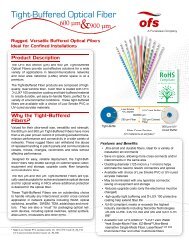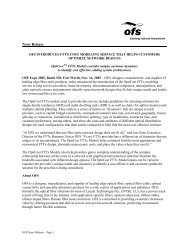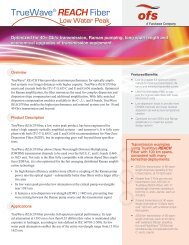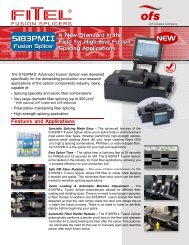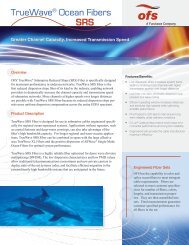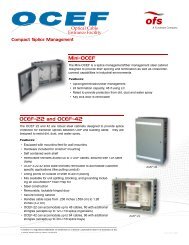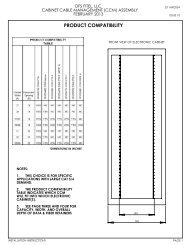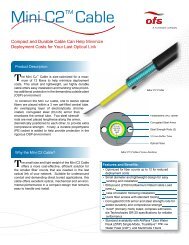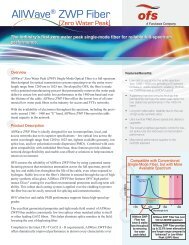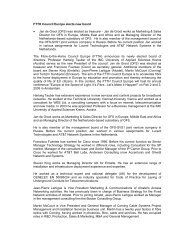BICSI News Magazine - OFS
BICSI News Magazine - OFS
BICSI News Magazine - OFS
You also want an ePaper? Increase the reach of your titles
YUMPU automatically turns print PDFs into web optimized ePapers that Google loves.
to travel than those traveling along<br />
the edge, the refractive index profile<br />
in a multimode fiber must be graded<br />
in a parabolic manner across the core.<br />
This slows down the modes that have a<br />
shorter distance to travel, equalizing the<br />
arrival time of all the modes.<br />
The better the modes are equalized,<br />
the higher the bandwidth of the fiber.<br />
Mode equalization depends on how<br />
well the graded index profile is<br />
constructed during fiber manufacturing.<br />
The more precise the refractive index<br />
profile is in terms of shape, curvature<br />
and smoothness (free of dips, spikes or<br />
defects), the better the modes will be<br />
equalized (see Figure 2).<br />
OM4 fiber, with its higher<br />
bandwidth, has an extremely precise<br />
refractive index profile—virtually free<br />
of perturbations or defects. In order<br />
to make such a precise fiber, one<br />
needs to use a preform manufacturing<br />
process that has exceptional control<br />
over the amount of germanium that is<br />
incorporated at particular submicron<br />
positions within the fiber’s core. An<br />
example of such a process that lends<br />
itself to this level of control is the<br />
patented modified chemical vapor<br />
deposition (MCVD) process, where<br />
each layer of the core is deposited and<br />
sintered individually, providing the<br />
utmost in refractive index precision<br />
and uniformity.<br />
The OM4 Fiber Standard<br />
Two standards define the use of<br />
OM4 fiber in high-speed networks—<br />
TIA-492AAAD, which contains the<br />
OM4 fiber performance specifications,<br />
and the IEC 60793-2-10 international<br />
standard, which provides equivalent<br />
OM4 specifications under fiber type<br />
A1a.3.<br />
ISO/IEC 11801 will add OM4<br />
fiber as an industry-recognized fiber<br />
type, and IEEE 802.3ba for 40 Gigabit<br />
Ethernet (GbE) and 100 GbE will<br />
include OM4 fiber as an option that<br />
provides a reach of 150 m (492 ft),<br />
which is 50 percent greater than OM3.<br />
Figure 3: Different VCELS fill a different set of modes in each fiber,<br />
which can affect pulse spreading (bandwidth).<br />
There was discussion and debate<br />
within the standards groups about a<br />
minimum OFL bandwidth requirement<br />
at 850 nm. Although current<br />
applications primarily use 850 nm<br />
VCSEL lasers with fibers that are<br />
specified to a minimum EMB, there<br />
was good reason to also establish a<br />
minimum 850 nm OFL bandwidth<br />
specification. It has been shown that<br />
fibers with higher OFL bandwidth will<br />
perform better with VCSELs that launch<br />
more power into outer modes. That is<br />
why the existing OM3 fiber standards<br />
require a minimum 1500 MHz•km OFL<br />
bandwidth at 850 nm.<br />
For OM4, the standards group<br />
strongly recommended at least 3500<br />
MHz•km OFL bandwidth in order<br />
to ensure the utmost performance<br />
and reliability. Ultimately, that is the<br />
specification that was agreed upon.<br />
How Laser Bandwidth is<br />
Measured<br />
Bandwidth performance of OM4<br />
fiber is ensured using the same criteria<br />
as OM3, but with much tighter<br />
specifications. Due to a challenge posed<br />
when the now-familiar VCSEL was first<br />
introduced, new measurement methods<br />
had to be developed to verify laser<br />
bandwidth of OM3 and OM4 fibers.<br />
Unlike an LED, laser VCSELs produce an<br />
energy output that is not uniform—it<br />
can change sharply across the face of<br />
the output. What’s more, each laser<br />
fills a different set of light paths in<br />
each fiber and does so with differing<br />
amounts of power in each path (see<br />
Figure 3). Overfilled bandwidth<br />
measurements used to measure LED<br />
bandwidth could not emulate the<br />
operation of a VCSEL.<br />
The standards allow two ways to<br />
measure and verify laser bandwidth—<br />
the DMD mask method and the<br />
effective modal bandwidth calculated<br />
(EMBc) method. Both methods require<br />
DMD testing—the difference lies in<br />
how the DMD data is used and<br />
interpreted.<br />
In DMD testing, small, highpowered<br />
laser pulses are transmitted<br />
through the fiber in tiny steps across<br />
the entire core of the fiber. Only a<br />
few modes are excited at each step,<br />
and their arrival times are recorded.<br />
The DMD of the fiber is the difference<br />
between the earliest and the latest<br />
arrival times of all modes at all steps.<br />
DMD measurement is currently<br />
the only reliable method for verifying<br />
bandwidth required for 10 Gb/s<br />
performance, because it is the only<br />
method that checks all modes across<br />
the fiber core independently. For that<br />
reason, industry associations such as<br />
TIA/EIA and ISO/IEC have published<br />
standards for DMD measurement and<br />
DMD specifications for laser-optimized<br />
multimode fiber.<br />
Electronic reprint with permission from <strong>BICSI</strong> <strong>News</strong> <strong>Magazine</strong>-May/June 2010 Issue



